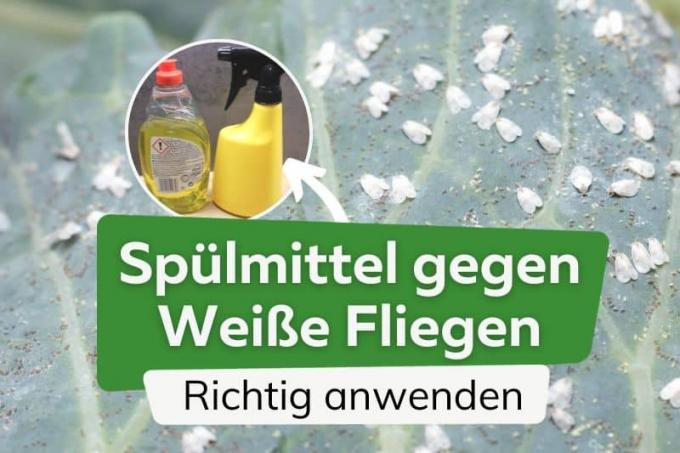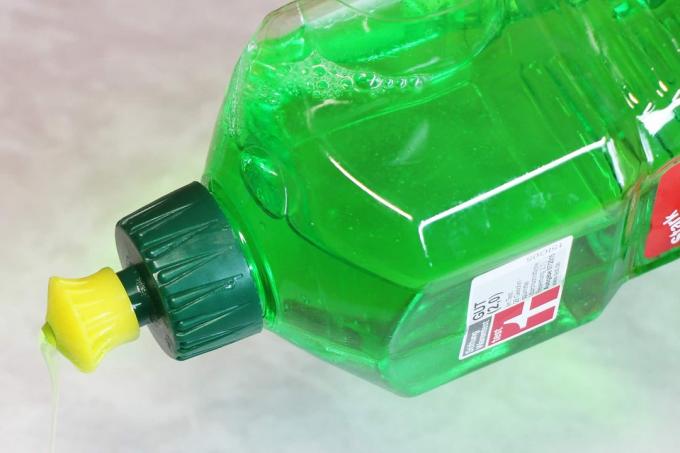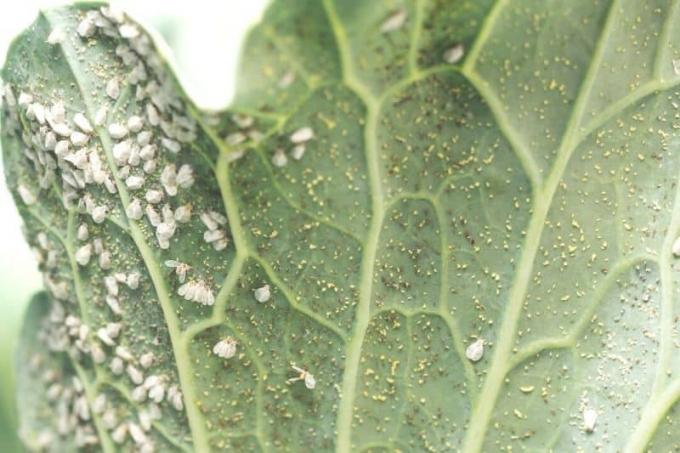
Experienced plant lovers use home remedies to control pests. The dreaded cabbage whitefly is particularly common in greenhouses and on indoor plants. However, you can quickly get rid of the whitefly with a simple water-based oil-dishwashing liquid mixture.
In a nutshell
- make an oil-water emulsion with dishwashing liquid
- use as a spray on infested plants
- apply a maximum of three times
- spray only in the evening do not expose sprayed plants to the sun
- do not treat young plants
Table of contents
- Oil emulsion with detergent
- Application
- time of treatment
- frequently asked Questions
Oil emulsion with detergent
Detergent alone doesn't help against the whitefly. However, you can use this household item to create a simple oil and water emulsion that can be used as a spray treatment and will suffocate the pests. Make the mixture as follows:
- a liter of soft water
- with two tablespoons of canola oil
- and a good squirt of dish soap
Pour into a spray bottle and shake vigorously. The detergent acts as an emulsifier and ensures that the water and oil combine.

Tip: Instead of rapeseed oil you can also use ten drops tea tree oil or neem oil take. The latter also has a natural insecticidal effect.
Application
Prepare the spray freshly from water, oil and washing-up liquid before each use, as it quickly becomes rancid and then loses its effectiveness in the fight against whitefly. Then apply it like this:
- Cover soil/substrate around the plant
- Oil emulsion must not seep into the ground
- causes soil pollution
- could cause damage to plants, e.g. B. Clogging of the ducts
- Spray the plant until dripping wet
- Don't forget the underside of the leaves!
Now let the home remedy take effect and repeat the application after two to three days if necessary. The effect can be enhanced by placing potted plants in a cool place. The whitefly does not tolerate this climate.

Tip: Whiteflies usually lay their eggs on the underside of the leaves. You can wipe them off with a cloth or Simply cut off heavily infested leaves and dispose of them in the household waste. Don't throw them in the compost!
time of treatment
But be careful: do not spray the mixture of water, oil and detergent against whiteflies more than three times per plant and above all: only do the treatment in the evening! The film of oil dissolves the natural wax coating on the leaves, which in turn protects them from excessive evaporation. After such a spray treatment, blazing sun should be avoided as far as possible, as this can result in severe water loss and leaf burns. However, this protective layer regenerates very quickly. Potted plants can simply be placed in a more shady spot for the treatment period.
A notice: Young plants should not be treated with oil and washing-up liquid as they can be very sensitive to it.
frequently asked Questions
A single treatment is not sufficient for successful whitefly treatment as larvae and eggs may be missed and may survive. Therefore, at least two, better three, runs should be carried out at intervals of several days.
A classic, tried-and-tested home remedy against whiteflies are also yellow panels that are simply set up or hung up between the plants in the greenhouse at regular intervals. There are yellow boards for potted plants that can be stuck into the potting soil. The pests stick to the boards and can no longer multiply. Instead of oil and washing-up liquid, you can also grate solid soft soap, dissolve it in warm water and use it as a spray when cooled.
In addition, whiteflies seem to avoid the scent of some plants, which is why they use thyme, sage, basil or marigolds between endangered plants - especially cabbage and tomato plants - as a preventive measure can. Settle beneficial insects such as ladybugs, parasitic wasps, etc. through close-to-nature management. to hunt down the vermin. Ichneumon wasps are attracted, for example, to native wild herbs such as chervil.
This question can be answered with an unequivocal “yes”. Get rid of the whitefly as soon as possible, because the pests multiply rapidly. The hungry larvae feed on the sap of the plant, significantly weakening infested plants. They also leave behind sticky excretions called honeydew, which in turn is colonized by sooty mold.



